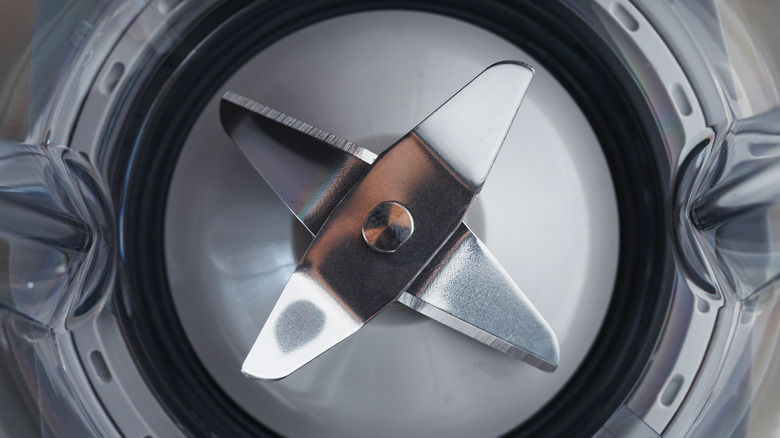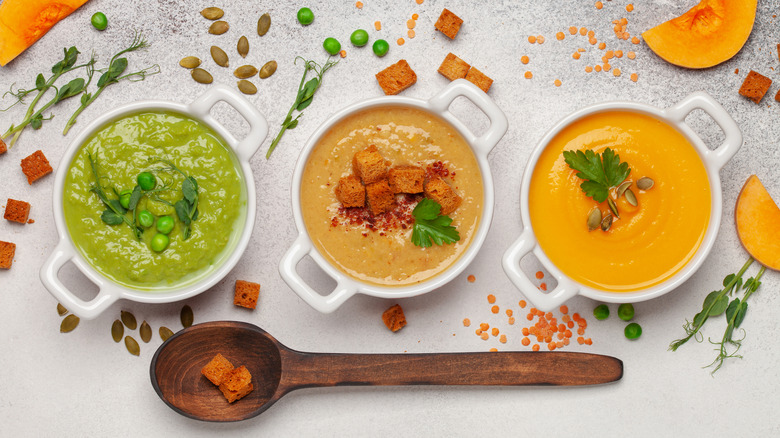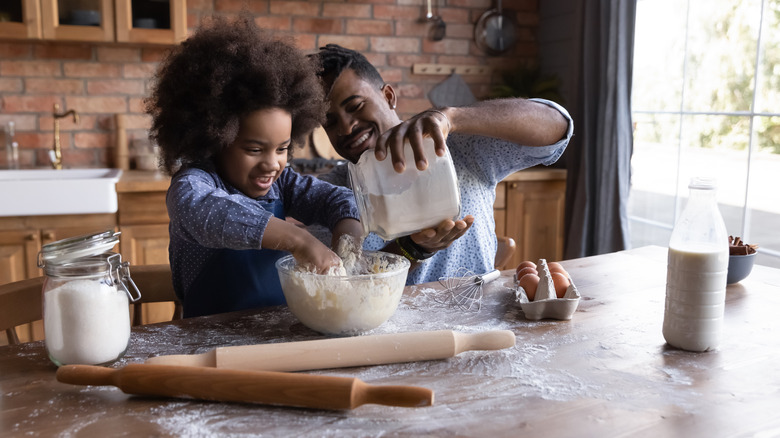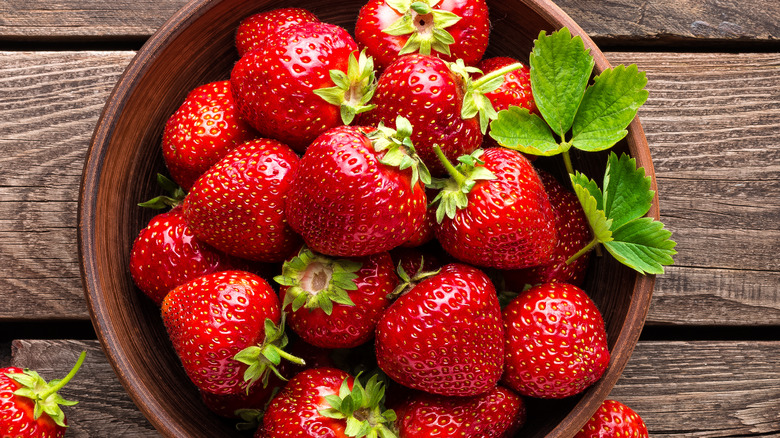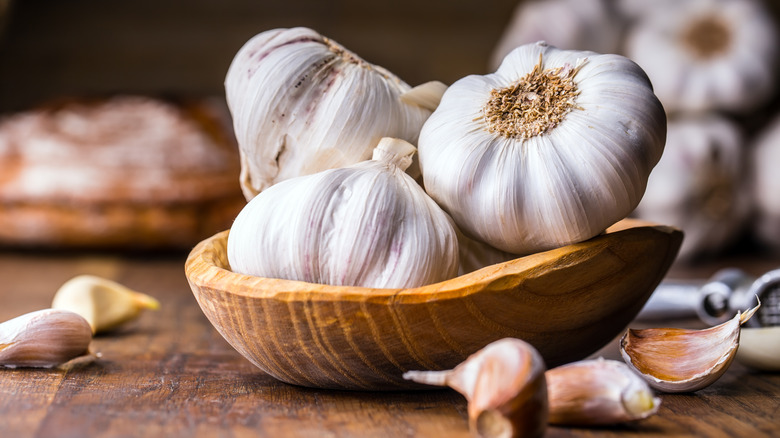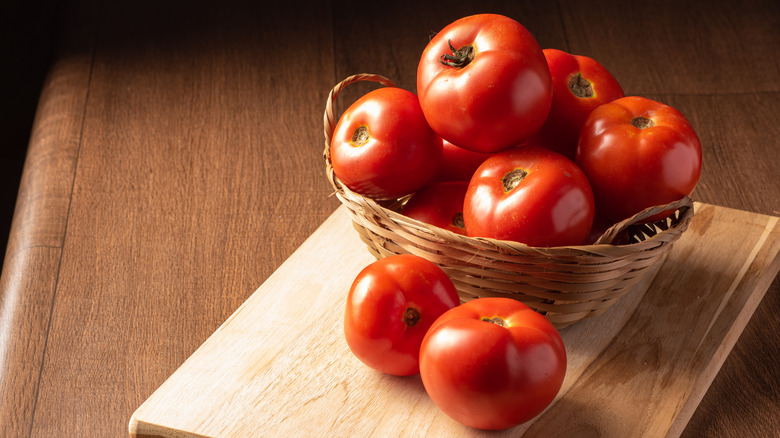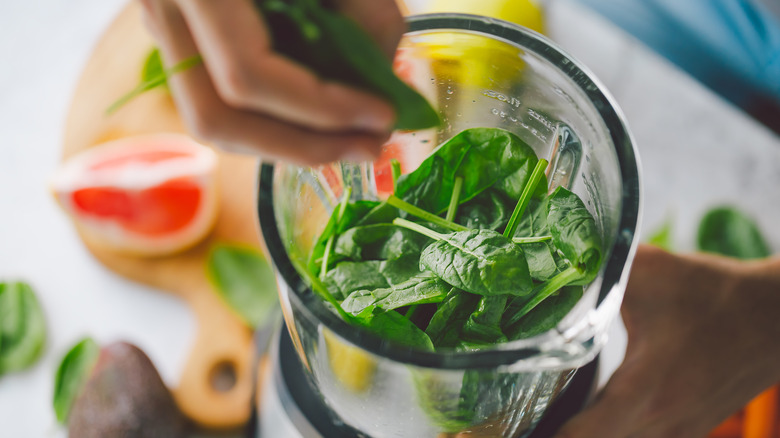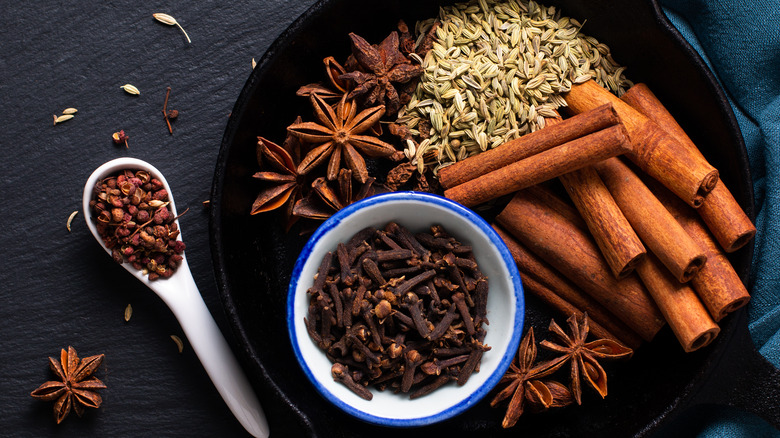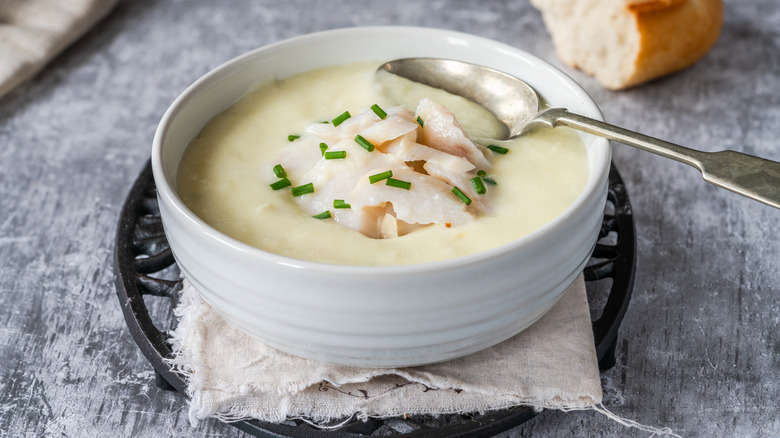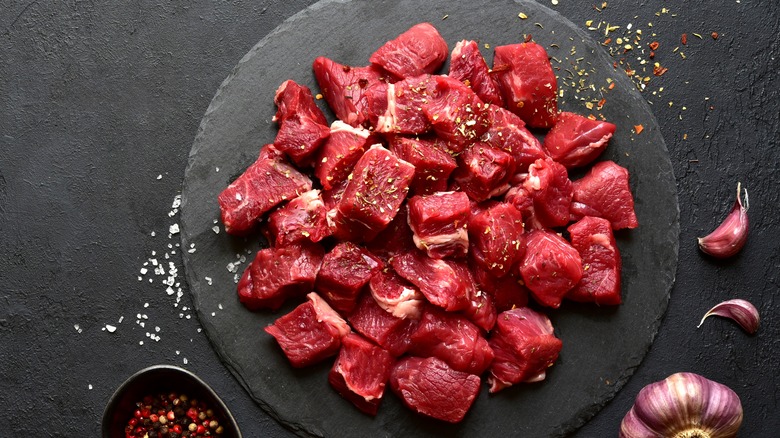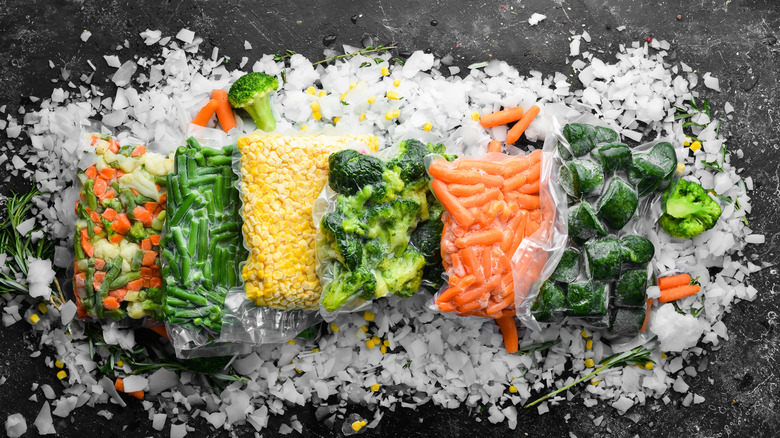Foods You Should Avoid Putting In Your Blender
Whether you're whipping up refreshing smoothies for a blistering day or making hearty bisques for a rainy one, a blender is likely the appliance you'll gravitate towards to get the job done. This practical and efficient gadget has been around since 1922 (via Los Angeles Daily News), and its capabilities have evolved quite a bit since then. Modern versions have powerful motors and large containers that can hold several cups of food at once, making it easier to fulfill your blending, grinding, emulsifying, or chopping needs.
But even top-of-the-line blenders aren't equipped to handle everything that gets tossed into them (and we're not just referring to obvious hazards like bones and shells). Not only can mechanical issues occur to the blender itself, but some foods have the ability to become ravaged when spun with a forceful blade. The next time you put your blender to work, think twice before using it to prepare these foods.
Mashed potatoes
We know what you're thinking — using the blender is the perfect shortcut for mashing potatoes! Unfortunately, this is not the case. Although a blender may leave your mashed potatoes lump-free, it is bound to make them overly elastic. Nobody wants to feel like they're chewing on a piece of gum when they were expecting to eat a comfort food delicacy! The main reason why you should never use a blender for mashed potatoes comes down to the high level of starch in spuds. When starch is constantly worked, it tends to rupture, causing it to tighten up.
But have no fear, there are plenty of techniques that can be used to prevent gluey mashed potatoes. If you have a Kitchen Aid, using your paddle attachment will get the job done in no time. Then, of course, a good old-fashioned potato masher will never let you down as well. Or heck, even a nifty fork can work wonders when you're in a pinch. There are even mashers on the market that are designed to make large quantities of mashed potatoes at once if that's what you're looking to do. Considering these approaches, there is bound to be an option that allows you to avoid the blender at all costs.
Hot foods and liquids
Though many recipes call for putting hot soup and other liquids in a blender, it is surprisingly a very unsafe practice that may result in the blender exploding. When hot matter such as soup is placed in a confined space including a blender, it has the potential to expand. According to Kitchen Parade, any type of hot air naturally expands and moves upward, which is the key reason why this is such a dangerous practice to perform. In the lesser of repercussions, the lid itself might pop off and create an ultra-mess in your kitchen. Who wants to clean broccoli soup off their ceiling?
Some blenders can handle heat better than others, but in general, it is smartest to use another tool when blending hot liquids. Nutribullet is well-known for having some of the most outstanding blenders on the market, yet the company advises against pouring high-temperature foods into its machines. If you're thinking of making a cream soup, an immersion blender is a clever way to go. However, if your blender is the only option you have on hand, play it safe by allowing the liquid to cool before blending it.
Doughs and batters
If there is anything you certainly shouldn't put in a blender, it's dough. Most doughs and cake batters contain gluten, which is a very delicate ingredient that can easily become overworked. Using a blender will cut into the gluten strands, causing the final product to become tough since the blades will typically handle the dough or batter in a rough manner. According to Bob's Red Mill, once gluten has been over-stretched, there is no fixing it. Therefore, it is better not to risk it in the first place. In addition, many blender companies such as Cuisinart state in the user's guide that blenders are not made to knead dough in the first place.
If you're making bread and don't have a standing mixer with the proper attachments, your best bet is to knead bread dough by hand so you can evaluate its texture throughout the process. For cake batters, a blender would certainly break up the lumps you're looking to smooth out, but it will result in a rubbery mixture. If you're preparing a cake batter by hand, break up the dry lumps with a whisk. You could even press the dry ingredients through a sifter to make it a fine powder. This should be done before adding in your wet ingredients and will save you a lot of trouble. Next time you are on a mission to make a chewy brownie, keep this in mind.
Whole fruits
Even though blenders are known for chopping and puréeing fruit, we recommend cutting your fruits into small pieces before putting them in a blender. Throwing in large chunks of food has the potential to overwork your machine and its motor, leading the blender to break down. According to Cuisinart, the food you put into a blender should typically not be larger than 1-inch pieces. It is essential to read your specific blender's manual to review the recommended size for foods to put in it, but to keep it safe, bite-sized bits are the safest bet.
So how about putting in fruits that have a peel or skin on them? Tough exteriors like orange peels are likely to get stuck in the blade, but fruit that has been chopped and contains a softer skin (kiwi, for example) shouldn't be an issue. In addition to the probability of breaking your machine, tossing in whole fruits will leave your food chunky. Whether you're looking to make a fruit purée or a smoothie bowl, you'll want it to turn out as silky as possible.
coffee beans
When it comes to your morning cup of joe, resist the temptation to grind your coffee beans in a blender (via Kaapi Machines). Not only will a blender render your beans as stony segments rather than smoothly ground particles, but it can cause your coffee to give off a scorched flavor once it has been brewed. The integrity of your coffee isn't the only issue here. The blade in your blender will likely become jammed when mixing something so dry. This can end up dulling the blade or chipping it. Ultimately, using these practices may cause the equipment to malfunction.
If you prefer your java brewed from beans that have been freshly ground, stick with using a coffee grinder. That way you can ensure the perfect grind for your cappuccino or next batch of cold brew, plus you won't have to constantly worry that your machine may break down.
Strong smelling foods
The next time you want to put ingredients like garlic or jalapeño in your blender, we suggest you reconsider. While these bold foods offer a welcome punch to your meal, that intensity can make it difficult to efficiently clean your machine (via Techradar). Although garlic is incredibly healthy for you and boosts the flavor of your dishes, you should try rough chopping it by hand rather than blending it. If not, you might find yourself tasting notes of garlic on blended foods for weeks to come.
Certain peppers, specifically chili peppers, will transfer their heat to the material and straggle there until it has been deep cleaned. Even Blendtec blenders, which are typically self-cleaning, are no match for chili peppers, and a thorough scrub involving bleach will likely be required to clean up the residue.
To avoid having to soak your machine in harsh chemicals, there are other ways to mash and break down these powerfully aromatic foods. Try making a fresh garlic paste by mincing the vegetable and letting it marinate with salt. This will break the substance down into a puree! For chili peppers, you can always cook them down, then use a masher to turn them into a sauce.
Fresh tomatoes for sauce
Let's say you want to try making a rich, homemade tomato sauce. A blender will work just fine, right? Well, not if you want to avoid creating an orange-foamy mess. The reason behind this, according to Thrive Cuisine, is because of the blender's design; the appliance incorporates air into whatever food you are pureeing. In most instances, this doesn't cause any harm to the food, but in the case of fresh tomatoes, it will cause considerable discoloration and unwanted change in texture.
No need to worry though, there are better ways out there to make your sauce. There are even methods that require no special machines at all. You can end up with a delightful tomato sauce by simply simmering the sauce using the low and slow method, steadily cooking the tomatoes down. After they've simmered long enough, they'll be soft enough to mash by hand. You can do this by using a couple of distinct tools. A potato masher is the unexpected tool celebrity chef Scott Conant uses for tomato sauce, but a food mill will also work wonders.
Room temperature leafy greens
Green smoothies and spinach dips are just a couple of flavorsome foods you can make in a blender using leafy greens. Unfortunately, sometimes you end up with brown mush if you're not careful about handling your plant ingredients.
It is best to keep your leafy greens refrigerated until you use them; having them sit out at room temperature before incorporating them into a recipe will have negative effects on the appearance of the food. According to chef John May, the best way to store your leafy greens is to place them in bag with holes punched it and keep your stash in the fridge (avoid the crisper since the lower temperature may end up killing off nutrients).
Plants such as spinach are similar to apples and potatoes in the way that natural oxidation occurs, especially when they are put under heat (via The Guardian). The heat that the blade of a blender puts off is often disregarded, but it is something to make note of when dealing with these types of foods. The temperature change is enough to break down the cell structure, permanently changing the pigment of your food. If you're going to toss lettuce or even kale in your machine, just make sure it has been chilled beforehand, and blend the ingredients in short spurts to avoid the blade from getting hot.
Whole spices
Freshly grinding spices is preferred for maximizing flavor, but using a blender is not the most proficient way to make that happen. In general, there should usually be some type of liquid involved when using your machine. At the very least, ingredients should have natural water in them that can be disbursed in the process of blending. According to Vitamix, grinding certain spices (as well as dry herbs) may not only damage your blender, but the oils that are released can discolor the machine and the lingering odors could affect the flavor of future foods you take for a spin.
Aside from ruining the blade, the consistency of the spices will likely not impress you either — likely an unwanted mixture of big chunks and fine powder. The blender can also create dust in the air (particularly when you're grinding peppercorns) that has a hard time settling (Via Cook's Illustrated). If falling short on a perfectly even grind doesn't intimidate you, just make sure your specific machine can handle the dry ingredients.
There are luckily many other paths you can take to successfully crush spices. Using a spice grinder is the most obvious way, but if you don't have one of those, put some elbow grease into it by utilizing a mortar and pestle set. All you need to do is simply fill the bowl ¼ of the way full and slowly twist and process the spices until they have become ground into the right consistency.
Thick foods and liquids
Mixing dense foods by using a standard blender is a disaster waiting to happen. No matter how powerful your blender may seem, pulverizing bulky foods will take some time, during which your blender can become overheated rather quickly (via Katom). Even if you try to take it easy by having the blender run in short increments, it is still excessive stress for the appliance. The constant labor put on the motor and blade could potentially cause the equipment to malfunction. This warrants not only a fire hazard but also a risk in reducing your machine's lifetime.
Putting yourself in danger for the sake of a side dish is not the way to go. If you're in search of an appliance that will give you the velvety texture you're looking for, a food processor is the better option. According to Kitchenaid, If the food you are making is so solid that you have to take bites of it rather than drink it, it is time to pull out the food processor instead.
Meat
Although it may be tempting to use your blender as a replacement for a meat grinder, there are far better options out there. Depending on what kind of blender you have, the machine has the ability to over-mix the meat if you're not careful (via Livestrong). Over-processing of raw meat can negatively change the texture, and ultimately the final product (via Today). This can turn your meal from a winner to a catastrophe in no time. If you don't have access to a meat grinder, a food processor might be your next best option, as you have more control over the machine (via Chicago Tribune).
Ideally, it is best recommended to buy your meat already ground. The USDA warns against grinding meat at home, as it increases the likelihood of cross-contamination. When you mix raw meat, the dangerous bacteria that was sitting on the outside has now gotten mixed in throughout the whole product. It is better to keep it safe and buy your meat already ground or go to a professional butcher. In addition, the bacteria from your raw meat will be all over your blender's surface, especially in hard-to-reach places. This means cleaning it safely becomes a lot trickier.
Frozen fruits and vegetables
Before going on your next smoothie adventure, think twice before shoving your blender full of whole frozen vegetables and fruits — and yes, that includes berries. This is because frozen ingredients have the potential to cause major strain on your blender's blade (via Cuisinart). Constantly blending hard ingredients over time will damage the blade and we don't want that.
Lucky for you, there are a couple of options to thaw the fruit quickly. Using a microwave on low or the defrost setting is sure to do the trick. Just make sure to heat in short segments and mix the frozen components in between cooking times. Another trouble-free method you can use to defrost your frozen fruit or vegetables is to run them under cold running water. Both of these techniques will soften the fruit enough to put them in a blender safely. Overall, it is best to refer to your blender's user manual when having any doubts about safe practices regarding your appliance. At the end of the day, If you play it safe by following these general guidelines, your blender will certainly thank you.
